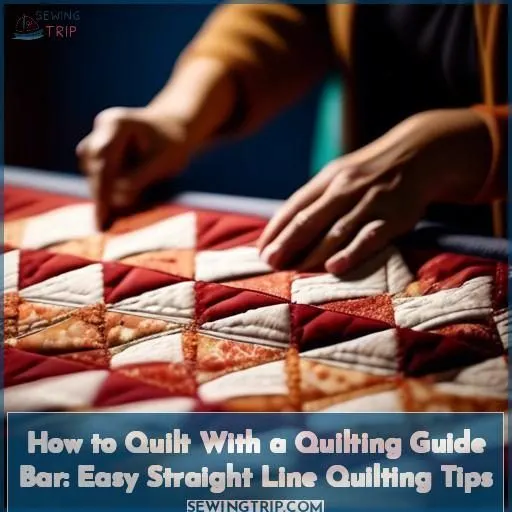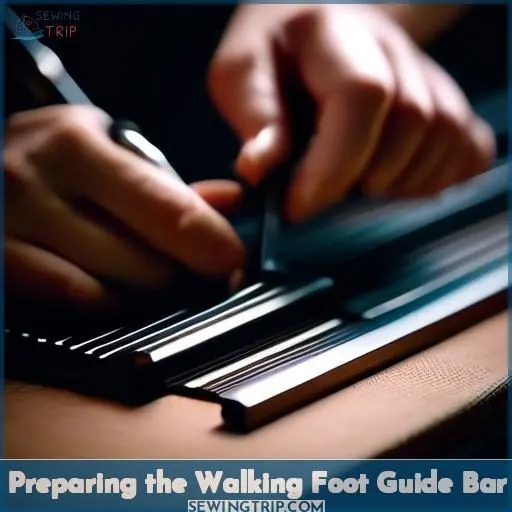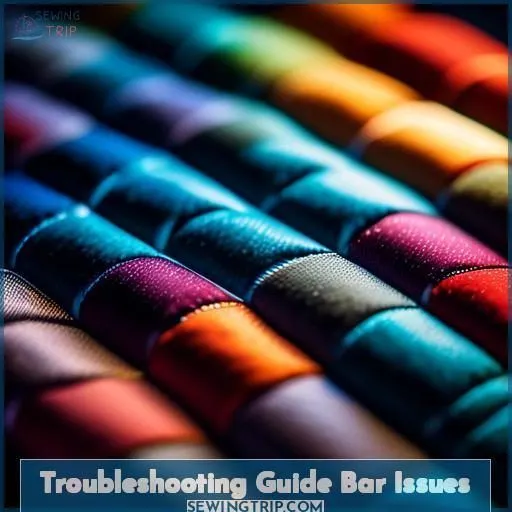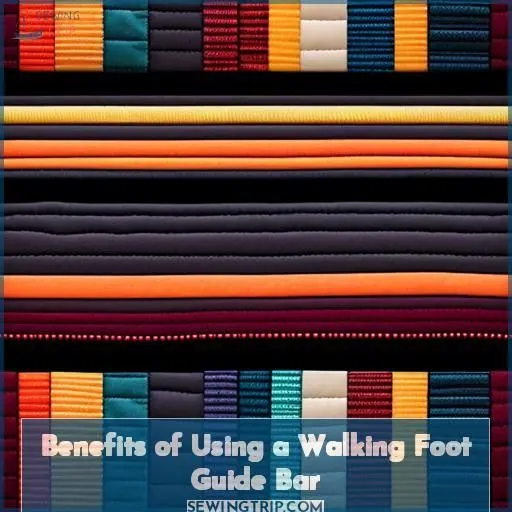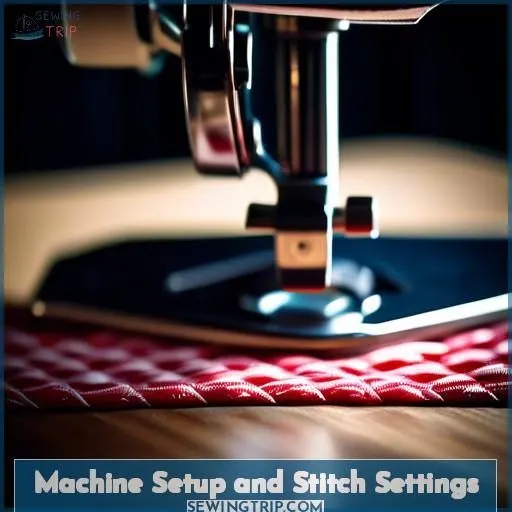This site is supported by our readers. We may earn a commission, at no cost to you, if you purchase through links.
To quilt with a quilting guide bar, first insert it into your walking foot and adjust the distance for precision.
Slide the bar through the foot hole, pointing it down for alignment.
Make an anchor stitch, then line up the bar with your previous stitch and sew.
The guide bar helps align the fabric and create consistent, even stitches for free motion and ruler quilting.
If problems arise, verify its attachment, check for damage, and refer to the manual.
Using a guide bar provides precise guide placement, flexibility, and ease of use.
Want to maximize its benefits and set up your machine correctly? Keep reading to learn more.
Table Of Contents
Key Takeaways
- To quilt with a guide bar, insert it into your walking foot and adjust the distance for precision.
- Use the guide bar for both free motion and ruler quilting to create consistent, even stitches.
- Troubleshoot guide bar issues by checking the attachment, examining for damage, and referring to the manual.
- Benefits of using a guide bar include precise guide placement, versatility for different techniques, and ease of use.
How to Quilt With Quilting Guide Bar?
To quilt with a quilting guide bar, you should first make sure that the bar is securely fastened in the channel of the walking foot.
This can be done by pushing the bar down into the small groove or by using a screw to tighten it in place.
The guide bar should rest on your fabric surface at the distance of the grid lines you want to sew, allowing for evenly-spaced lines, especially for grid quilting.
When using the guide bar, focus on the guide bar rather than the stitch line to prevent it from moving off to the side.
Preparing the Walking Foot Guide Bar
To prepare the walking foot guide bar for quilting, you’ll first need to insert it into the walking foot.
This can be done from either side of the foot, and the distance can be adjusted by pushing or pulling the guide.
Once attached, the guide bar provides accuracy and consistency, helping you create precise lines and patterns in your quilting.
It’s a useful tool for both free motion quilting and quilting with a ruler, ensuring your fabric stays aligned and your stitches are even.
Using the Guide Bar for Quilting
Using a guide bar with a walking foot is a game-changer for quilters. It provides a reference point for stitching, ensuring straight lines and precision in your quilting project. Here’s how to use it:
- Attach the Guide Bar: Slide the round end of the guide bar through the guide bar hole on your walking foot or sewing machine foot.
- Measure the Stitch Width: Adjust the guide bar until the tip of the bar is pointing down, which makes it easy to line up with the previous stitch.
- Make an Anchor Stitch: Before you use the guide bar to stitch, make an anchor stitch using tape or another marking tool.
- Use the Guide Bar: Line up the guide bar with your previous stitch and sew away.
The guide bar is particularly useful for straight line quilting, where it can help reduce errors and create consistent stitching. It’s also beneficial for free-motion machine quilting, as it provides a reference point for your stitching.
Troubleshooting Guide Bar Issues
If you’re encountering issues with your guide bar attachment, there are a few actions you can take to troubleshoot.
First, verify that the guide is firmly attached. If it slips or moves, it may not be adequately tightened or could be damaged.
Examine the guide closely to make sure it isn’t bent or damaged.
If the guide is too loose or too tight, you can modify the distance by pushing or pulling it.
If the guide bar isn’t functioning correctly, refer to the user manual or seek assistance from a technician.
Benefits of Using a Walking Foot Guide Bar
Using a walking foot guide bar provides several advantages for your quilting projects. Here are three key benefits:
- Precise Guide Placement: The guide bar guarantees that your stitching remains on track, even when you’re working on complex grid patterns or parallel lines. It functions as a reference point, aiding you in maintaining consistent fabric tension and alignment.
- Versatility for Different Techniques: Whether you’re into free motion quilting or working on appliqué projects, a guide bar can enhance your quilting experience. It simplifies the process of creating straight lines or grids, making your work more accurate and visually appealing.
- Ease of Use: With a guide bar, you can quilt with confidence, knowing that your stitches will be straight and consistent. It reduces the necessity for marking or measuring, saving you time and effort. Plus, it’s compatible with most walking feet, making it a versatile tool for your quilting arsenal.
Machine Setup and Stitch Settings
Preparing the machine for quilting with a guide bar involves:
Setting the needle to a Schmetz Quilting Needle, size 75.
Winding the bobbin with 60 wt. Bottom Line thread.
Selecting a 3.5 stitch width and 2.25 stitch length for the straight stitch setting.
Setting the walking foot with the guide bar 3/4 from the needle.
Adjusting the stitch density to suit your project and fabric type.
For thicker fabrics, consider a 4.0 stitch width and 2.5 stitch length.
Always follow the machine’s user manual for specific settings and recommendations.
Conclusion
Mastering the quilting guide bar opens a world of straight-line precision.
Once you’ve nailed the setup and troubleshooting, you’ll glide through projects with consistent, even stitches for free motion and ruler quilting.
Embrace this versatile tool.
It’ll become an indispensable part of your quilting arsenal, allowing you to elevate your craft with stunning, controlled lines every time you quilt with a quilting guide bar.

